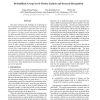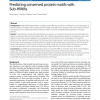155 search results - page 28 / 31 » Derivation of a Dialog Model from a Task Model by Activity C... |
NN
2002
Springer
13 years 10 months ago
2002
Springer
Recognition-by-components is one of the possible strategies proposed for object recognition by the brain, but little is known about the low-level mechanism by which the parts of o...
GECCO
1999
Springer
14 years 2 months ago
1999
Springer
This paper discusses the simulation results of a model of biological development for neural networks based on a regulatory genome. The model’s results are analyzed using the fra...
ICCV
2011
IEEE
12 years 10 months ago
2011
IEEE
This paper addresses the challenge of recognizing behavior of groups of individuals in unconstraint surveillance environments. As opposed to approaches that rely on agglomerative ...
WSNA
2003
ACM
14 years 3 months ago
2003
ACM
—In a sensor network, data routing is tightly coupled to the needs of a sensing task, and hence the application semantics. This paper introduces the novel idea of information-dir...
BMCBI
2010
13 years 5 months ago
2010
Background: Profile HMMs (hidden Markov models) provide effective methods for modeling the conserved regions of protein families. A limitation of the resulting domain models is th...



